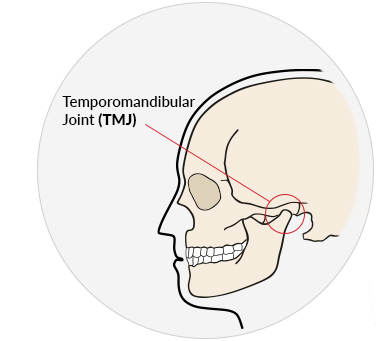Temporomandibular Joint Dysfunction
Temporomandibular Joint Dysfunction (TMJ, TMD)
What is Temporomandibular Joint Dysfunction?
Temporomandibular joint dysfunction (TMD) is a blanket term used to describe pain and dysfunction of the joint that connects your lower jaw to the temporal bone on each side of your face (the temporomandibular joint) and the muscles that move the jaw.
TMD symptoms include facial pain and tenderness, a clicking or popping sound in the jaw, and the jaw locking open or closed.
TMD may also be known as temporomandibular disorder, temporomandibular joint dysfunction, TMJ disorder, TMJ syndrome, TMJ, TMJD, or TM problems.
Causes | Symptoms | Treatment | Prevention
What is the Temporomandibular Joint (TMJ)?

The temporomandibular joint (TMJ) connects the lower jaw (mandible) to the temporal bone in the skull.
Located in front of your ears on both sides of your head, the TMJ is sliding hinge joint that can move side to side as well as forward and backward to allow you to talk, chew gum, or yawn.
The TMJ and the surrounding muscles and ligaments that support it is considered one of the most complex joints in the human body.
What Causes TMD?
There is no firm evidence as to a direct cause of TMD.
However, problems with how your teeth fit together (malocclusion), the muscles of your face or the joint itself can play a role in developing TMD.
Other potential causes of TMD include:
- Whiplash
- Stress
- Nail biting
- Gum chewing
- Gritting, grinding or clenching your teeth (bruxism)
- A heavy blow to the head or a direct hit to the jaw
- Osteoarthritis or rheumatoid arthritis
- Muscle tension in the head or neck
- Improperly fitting full or partial dentures
- Movement or dislocation of the soft cushion or disc between the ball and socket of the joint
What are the Signs and Symptoms of TMD?
The symptoms of TMD can affect your jaw as well as the muscles in your face, head, neck, and shoulders.
TMD symptoms can include:
- Jaw pain
- Facial pain or tenderness
- Neck and shoulder pain
- Pain in or around your ear when you open your mouth wide, speak or chew
- Headaches, earaches, or toothaches
- Feeling like your face is “tired”
- Swelling on one side of your face
- Jaw locking or getting “stuck” open or closed
- Inability to open your mouth wide
- Problems chewing
- Upper and lower teeth don’t fit together properly
- Your bite suddenly becomes uncomfortable
- Popping, clicking, grating, or cracking when opening or closing your mouth
- Dizziness, ringing in the ears (tinnitus), or hearing loss
Symptoms of TMD can be short-term and temporary, or they can last for many years, becoming chronic.
How is TMD Treated?
TMD jaw pain can be successfully treated with simple at-home remedies, as well as in a clinical setting, using a combination of:
- Over the counter pain relievers
- Activity modification (avoid chewy foods)
- Stress management
- Cognitive behavioural therapy (CBT)
- Biofeedback
TMD treatments aim to reduce pain and get the jaw joint back to normal function by:
- Avoiding activities that aggravate the conditions
- Reducing stress and relaxing muscles
- Being mindful of jaw clenching (and stopping the activity)
If you grind or clench your teeth while sleeping, your dentist may recommend a mouthguard (dental splint).
TMJ Physiotherapy for TMD
TMJ physiotherapy can help reduce the pain and discomfort of both chronic and acute TMD and get the temporomandibular joint moving properly again.
The TMJ/TMD at pt Health physiotherapists use a combination of techniques to relax, release, and stretch tight muscles and scar tissue.
Depending on the severity of your TMD, physiotherapy can include:
- Strengthening, flexibility, and range of motion jaw exercises
- Moist heat therapy to improve blood circulation
- Cold therapy to reduce swelling and reduce pain
- Massage therapy to decrease muscle tension
- Posture training to help correct any misalignment of the jaw
- Mobilization or movement exercises to improve the jaw’s range of motion
- Pain relieving modalities, such as:
- Therapeutic ultrasound to improve circulation and reduce pain and swelling
- Transcutaneous electrical nerve stimulation (TENS) to relieve pain and improve circulation
Does TMD Go Away On Its Own?
Yes, sometimes TMD can go away on its own without the need for a doctor’s care.
In a lot of cases, TMD symptoms are mild, don’t last long, and leave as quickly as they appear.
However, TMD can also be a chronic (long-lasting) and a painful group of conditions that can deeply impact your quality of life, at which point treatment is recommended.
Can You Prevent TMD?
As there is no known concrete cause of TMD there is little you can do to prevent it.
However, you can take steps to reduce symptoms such as our self-care tips below.
Home Remedies for TMD
If you have TMD there are some things you can do at home to manage your symptoms.
While we always suggest seeking the advice of a qualified physiotherapist, the following home care tips may help reduce symptoms of TMD:
- Practice good posture to reduce strain on the neck and shoulders
- Be mindful of clenching your teeth, try putting your tongue between your teeth to create a space and stop grinding your teeth
- Wear a mouthguard or splint at night to stop teeth clenching while you sleep
- Don’t rest your chin in your hands this places extra stress on the TMJ
- Speak to a physiotherapist about relaxation tips
- Avoid chewy foods and chewing on gum or ice
- Avoid opening your mouth really wide (as in yawning, singing or yelling)
- Speak to your dentist about any needed dental work for missing teeth or damaged crowns or bridges
- Use a heat or ice pack to relieve pain
Book a Physiotherapist Consult for TMD Today
